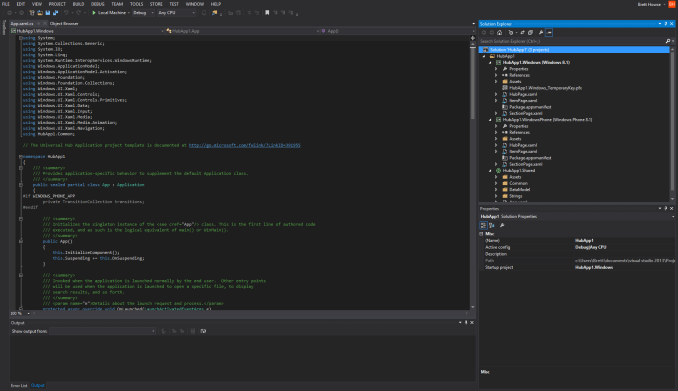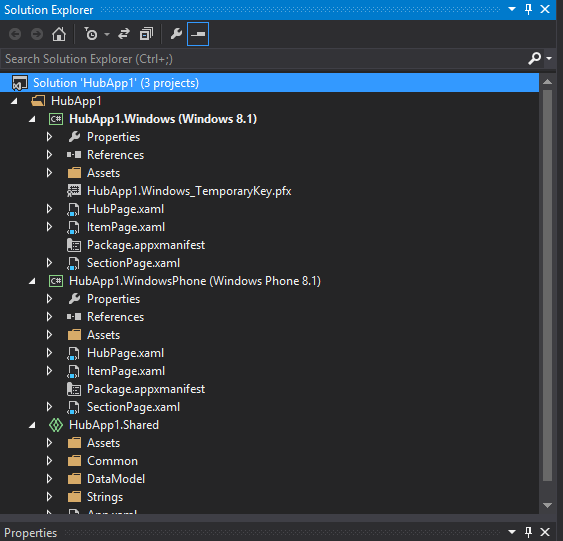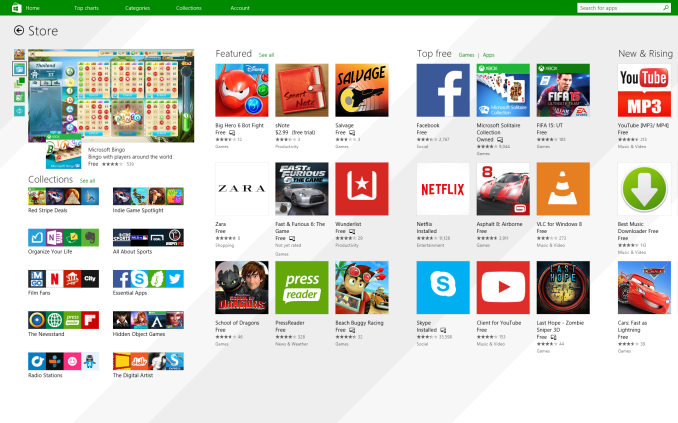Windows 10 Technical Preview First Impressions: The Return Of The Desktop
by Brett Howse on November 13, 2014 8:00 AM EST- Posted in
- Software
- Microsoft
- Windows 10
Universal Apps and the Windows Store
We just got done discussing why a single user interface for the OS across multiple devices is not always the ideal solution, so of course the obvious question with Universal Apps is why would you want it with the app model instead? Thankfully this is not the case although the term Universal App might lead people to believe they are attempting to have a single app target all of their platforms. The truth of the matter is that Universal Apps are Universal in the sense that they share a common app store.
If Microsoft is going to have Windows 10 succeed on desktops, laptops, tablets, phones, and even Xbox One, they need developer buy-in. A platform without apps is not much use to anyone. With the Universal App, they can bridge all of their platforms with a single App in the store. Under the hood, each app is created with a common framework of code, as well as multiple user interfaces in order to tailor the experience to the correct device type. Below is a screenshot of Visual Studio – Microsoft’s developer tools – with a new Universal App about to be created.
 Visual Studio Showing a Universal App Project
Visual Studio Showing a Universal App Project
As you can see, there is a shared portion of code, and then a project for the UI for Windows 8.1, and Windows Phone 8.1. Xbox One is not available yet, but should be added in a future release of Visual Studio.
A close up of the projects
But you may be wondering why any of this is necessary. Windows has the largest selection of applications of any system ever. That is of course true, and the Win32 framework has served both Windows and its users well over the years. But with the new WinRT framework there are some big advantages. First, it can be written to in multiple languages including HTML. WinRT supports C++/CX, C#, VB.NET, and HTML scripting with JavaScript and TypeScript. The security model for WinRT apps is a lot different than Win32, with all WinRT apps running in a sandbox mode for higher security. Unlike apps written in .NET, WinRT is native code, which should result in better performance. Contracts and Extensions are also new to WinRT, and allow apps to share data while still being in a sandbox. One of the biggest advantages of WinRT is that it is DPI aware, and can automatically scale apps appropriately based on screen size and screen resolution. Here, as we know, Win32 apps can struggle even though there are solutions in place.
Adobe Touch WinRT (left) vs Adobe Reader Win32 (right) on HiDPI display
One of the biggest disadvantages of WinRT is that it is only available on Windows 8 and newer devices. With Windows 8 struggling in the market as compared to Windows 7, the user reach of a developer targeting WinRT apps in the Windows Store would be for a subset of the total user base. With Windows 7 having over 50% of the desktop OS market share to itself, this is going to be an issue.
With Windows 10, Microsoft is certainly targeting Windows 7 users. If they can convince them to upgrade to the latest version of the operating system, then the new environment will have a much larger target base and will hopefully encourage developers to target the Windows Store. We have not heard of any upgrade promotions or pricing yet, but this is one of the biggest advantages Apple has had over the years. Their user base generally upgrades the OS at a much faster uptake than Windows. This allows developers to utilize newer APIs in the latest versions of their operating systems and keep the platform progressing. Microsoft has already had to deal with people being stuck on Windows XP, and they must be wanting to avoid that with Windows 7.
Since we are discussing Universal Apps and their advantages, one of the biggest advantages is the Windows Store. With Microsoft hosting the entire download and purchase of all WinRT apps, having user settings and apps sync from one device to another is much easier. One of the greatest experiences with Windows 8.1 is signing into a new PC for the first time. When you log in with your Microsoft Account, the system asks you if you would like to copy the devices and apps from one of your other devices, or if you want to start with a clean machine. If you choose a previous machine, all of the settings, wallpaper, Start Screen layout, and Windows Store apps are synced to the new device. In the case of Windows Store apps, the app itself is listed on your Start Screen, but it is not downloaded until the first time you select it. This avoids a situation where you will significantly delay the initial login time with a massive download, as well as avoid filling the available storage with apps you may not need on that particular device.
Also, like modern tablet and smartphone OSes, WinRT apps from the store are automatically kept up to date by the store. This avoids a lot of the issues with viruses and malware attacking an older version of a product since in theory it will not be around any longer.
The one thing missing from this are the older Win32 apps on the desktop, because they are not available in the Windows Store. Prior to Windows 10, desktop apps could be listed in the store, but the store would then link to the developer’s website to allow you to purchase and install the app. With Windows 10, rumors are that desktop apps will also be available and managed through the Windows Store. Assuming this does happen, then this will be a major boon to users. Desktop apps should in theory also be able to be kept up to date using the Windows Store which should cut back on the number of outdated pieces of software targeted by malware.
The Windows Store is a key piece of Windows 10. Universal Apps can be made available for multiple platforms through the store, and, if the rumors are true, even desktop apps will be available through the store. This should make the Out Of Box Experience (OOBE) very good for users with a Microsoft Account. The WinRT framework has not yet had the killer app written for it, so hopefully with Windows 10 the framework will be expanded to allow for more powerful apps to be created.













198 Comments
View All Comments
piiman - Saturday, November 15, 2014 - link
"roll back a bad or unwanted update"System Restore ring any bells?
Haravikk - Thursday, November 13, 2014 - link
I'm finding Windows 10 to be pretty good, in fact I'm using it as my main Windows version at the moment in spite of the risks (though my main OS is still Mac OS X so it's not a huge risk).It's definitely a lot more usable than Windows 8, but it does still have a way to go to really fix the desktop experience; most searches return results in Metro apps rather than desktop apps, regardless of which mode you're currently in, which is incredibly annoying. The search app is Metro only, which is weird, as all it does is spit out Bing search results with no apparently added value, so it might as well just send you to a web-browser. This is hopefully something that will be addressed during development.
I'm also a bit annoyed at the Windows Live account integration though; OneDrive is only available if you create a Microsoft account, but that means using the same password for your online account and your local machine, which IMO is insecure as it means I have a web-account with a weaker password just so I can remember it, rather than being able to set different passwords (or use a password manager). If you instead use a local account you can't use OneDrive, and you have to sign in to every single Microsoft service (e-mail, calendar, photos etc.) which is a huge pain in the ass compared to OS X's internet accounts system where you sign in once and interested apps can just request access.
Otherwise it takes the great technologies of Windows 8 and makes them a lot more useable, which is great; the live tiles on the start menu are a wonderful feature, rather than an impediment like the start screen on a desktop (it's admittedly great on a tablet).
At the same time though it just doesn't go far enough; there is still so much in Windows that is archaic and sorely in need of replacement. Things like tools from the Manage menu that looks fresh out of Windows 95 (and probably are), accessing settings is still a nightmare as they could be absolutely anywhere, with the control panels app still being a bit of a pain to use (at least search gets you where you need to be quickly some of the time). Windows 10's interface is really just veneer on very old, rotten wood; it's a nice veneer, but under the surface you can very quickly get mired in complex nonsense the moment you run into a driver problem, try to configure network connections etc. So it's not like this new interface is really a sea change in usability for Windows, it just makes Windows 8 more palatable to Windows 7 users.
darthrevan13 - Thursday, November 13, 2014 - link
Last time I checked Google did the same thing with their services (one password to rule them all) and nobody complained that it was insecure or even a problem for them. Besides, how else would you want to use OneDrive if you don't have a MS account?If you choose a MS account on Windows then it will automatically log you in all your MS services in IE only so I don't understand why you need to bash Win saying that OS X does it better, it's the stuff if you ask me.
wallysb01 - Thursday, November 13, 2014 - link
Its a little different when that “one password to rule them all” also has administrative privileges on your computer, than just having a lot of random web services tied to it.Haravikk - Friday, November 14, 2014 - link
I don't think I've explained it very well. Basically when you create an account in Windows 10 (and probably Windows 8, I don't know) you can create either a local account, or a "Microsoft Account". The former is just a classic account with its own password, while the latter requires you to use your Live.com login details, so it uses the same password. I just don't like it however, because I like nice, long (usually randomly generated) passwords for web-services, which of course is impossible to use with a Microsoft account, so it would force me to use something simple instead which I consider insecure.However, if you can only use OneDrive with a Microsoft Account, it won't let you sign in on a local account. You can sign in to mail, contacts etc. with a local account, but not OneDrive? They're basically forcing you to use an online account, which prevents me from using a strong password for the web-service side, and an easy to remember one for my actual user account, it's a pretty poor way to do it.
My other gripe was that if you want to use a local account, but still use your Live.com details to set up e-mail, calendars etc. then you have to enter the same details in each app, there's no way to just connect your Live.com to a local account so that apps can use it (or ask to use it).
In OS X you can setup a local user account, you can connect it to your Apple ID for recovery purposes, and you can also go into the internet accounts section and add your Apple ID as an iCloud account to enable all the various features it gives (iCloud Drive, calendar, e-mail etc.), which automatically configures all the relevant apps for, and lets third-party apps request the same details if they want them.
Basically Windows 10 (and possibly 8) force you to use your Live.com as login details for your computer if you want to get the most use out of it, and even blocks features (like OneDrive) if you don't. Meanwhile everything else is a pain in the ass to setup on the local account.
I'm not simply bashing Windows because I prefer how OS X does it, the way Windows does it is simply horrible; rather than giving the user flexibility, it forces you into one of two choices with their own drawbacks, rather than there being any best of both, even though they could easily give us one. In fact it's a regression from Windows 7, where you can setup a local account and link your Live.com account to it fairly easily.
Don't get me wrong, for some people using a Microsoft Account may be a great way to do things as it's simple, and involves no extra passwords, but I just don't think it's very secure, and I don't like that because I choose not to use it I'm not only losing features I had in Windows 7, but am also having to work harder to set everything up than I had under Windows 7. It's a huge step back.
asmian - Saturday, November 15, 2014 - link
"for some people using a Microsoft Account may be a great way to do things as it's simple, and involves no extra passwords, but I just don't think it's very secure"Ain't that the truth. Microsoft mail? Might just as well add an explicit CC to the NSA on everything, since we know they have complete back-door access to all MS's servers. Cloud or mail, if you have any wish for privacy this just isn't an option.
It'd be great if someone could write an app, like the old XP-Antispy, with a complete set of options in one place to reliably turn off all the MS account features and hidden privacy-leaking options.
attilakocsis - Thursday, November 13, 2014 - link
You can add additional sign-in options to your account (like PIN and picture password). So you can have a complex password for your Microsoft account and use e.g. a 4-digit PIN to access your computer. This is how I use mine - very convinient.lilmoe - Thursday, November 13, 2014 - link
Was about to say the same thing. I use a PIN instead of my password, very convenient.MrSpadge - Thursday, November 13, 2014 - link
Headlines like "The Return Of The Desktop" make me want to puke. It's not because of your article, Brett, but because of something I would characterize as a full-blown mass hysteria towards Win 8. As if the desktop was gone under Win 8.If one manages to look beyond the "modern" start screen (which you don't have to use) the Win 8/8.1 desktop is objectively better and more polished than 7 (explorer, task manager etc.). It even looks and feels better to me, although this is obviously highly subjective.
I recently had a short discussion with a colleague about a new PC:
"Yeah, it's got a fresh 8.1"
"8? Oh no!"
"Why?"
"Because every 2nd one is crap"
"... is that seriously the best argument you can come up with?"
Anecdotal, for sure, but shows how far this "Win 8 sucks hysteria" has brought us.
BobSwi - Thursday, November 13, 2014 - link
Microsoft Account is forced everywhere even when you've bypassed the initial setup with a local account (which is still a half hidden create a new ms account, cancel, and then make a local).Search riddled with Trending internet crap is embarrassing. Then another search bar in the start menu that you can't limit to local only so its searching store and internet when I'm looking for local application.
2 calculators, one metro & one old school, PC settings still all over the place. Charms is gone but different metro apps have their settings in different places now, do I Win+C or right-click, or look for elispes in top left for them. Not to mention half the metro apps work like crap in windowed mode, scroll bars really get hosed when not full screen.
Canned 'apps' seem to have more holding spots for ads, news weather etc. If I don't install windows w/ an MS account, I wished they'd just leave out all the canned apps and MS Store since I'll likely be removing them for business use anyway.